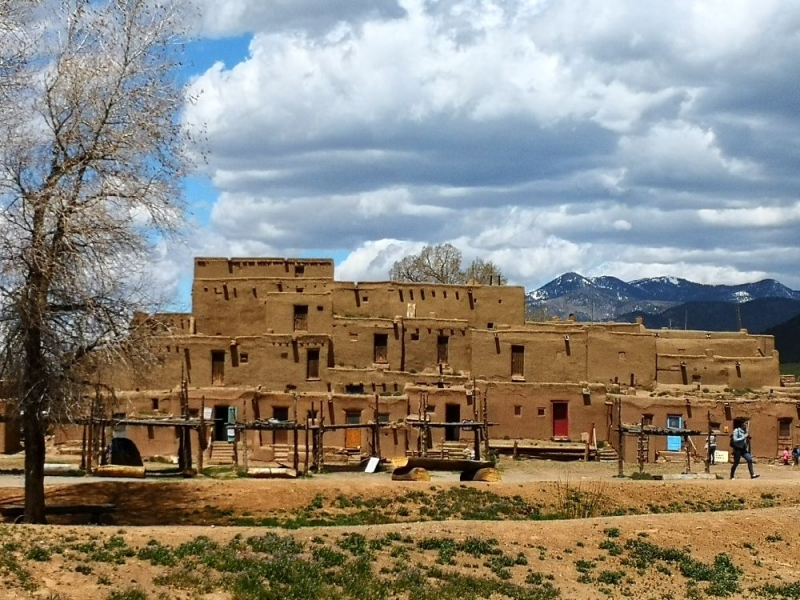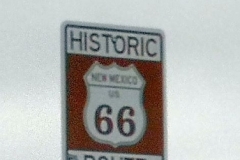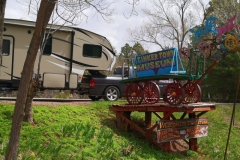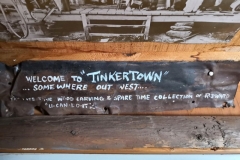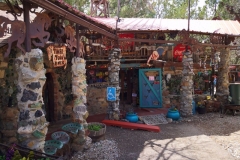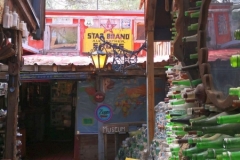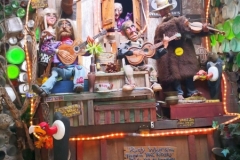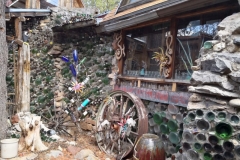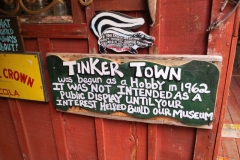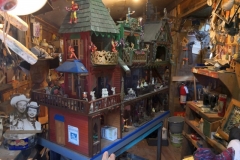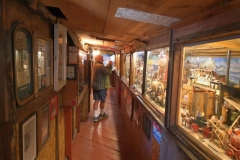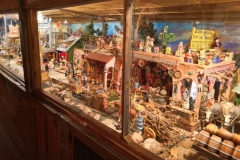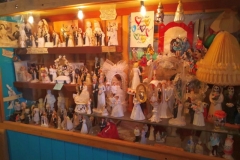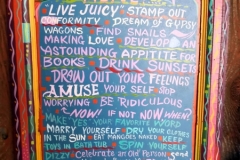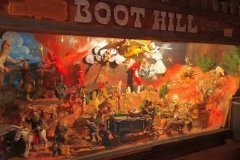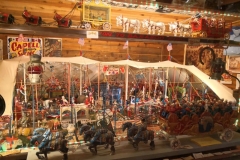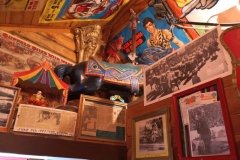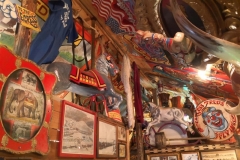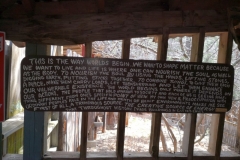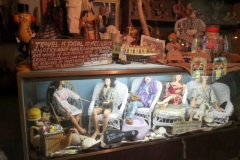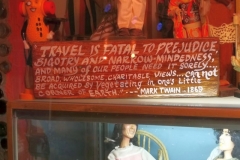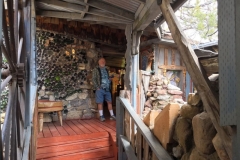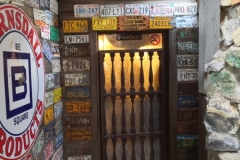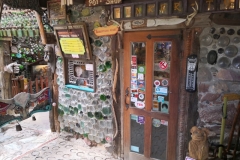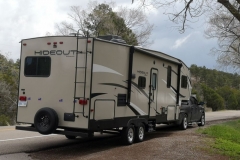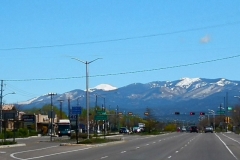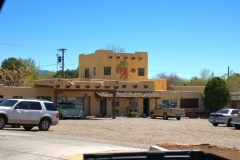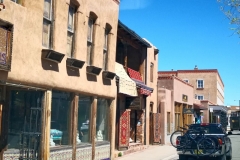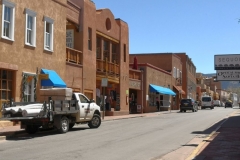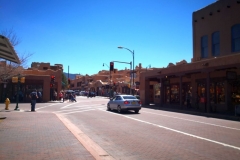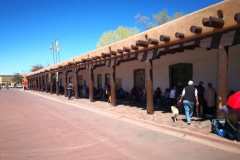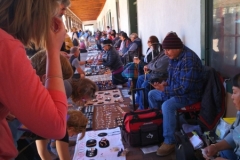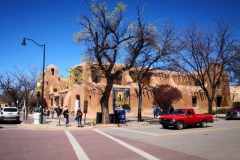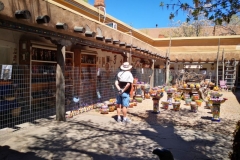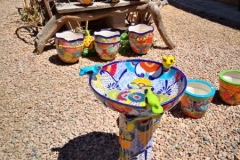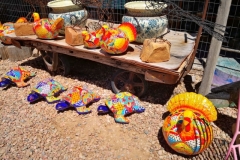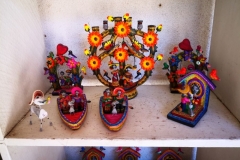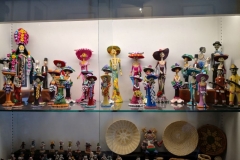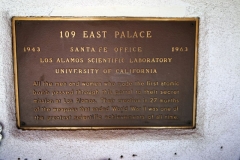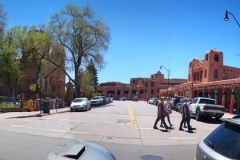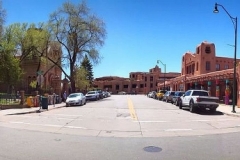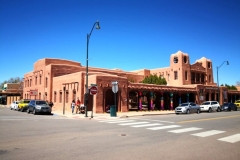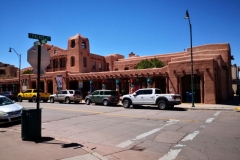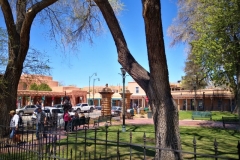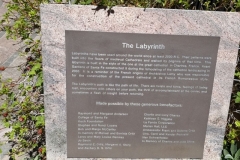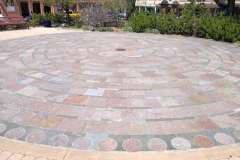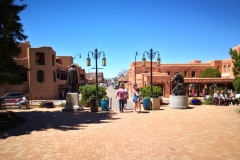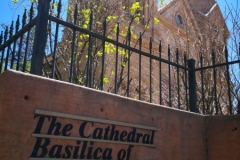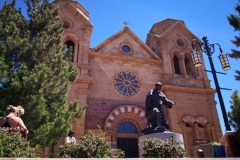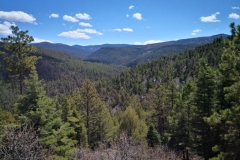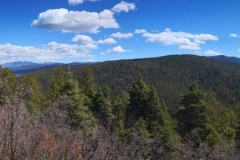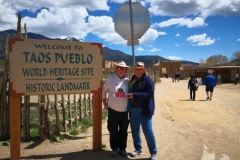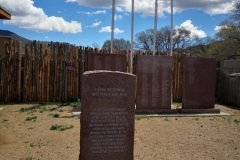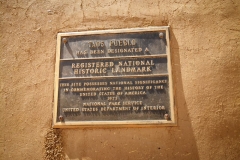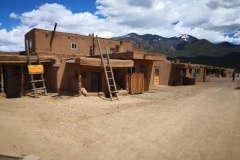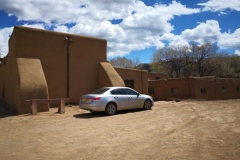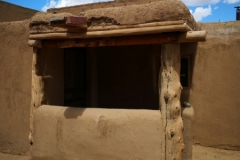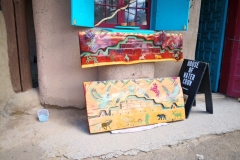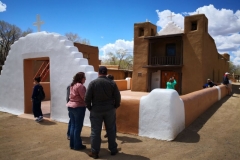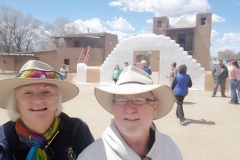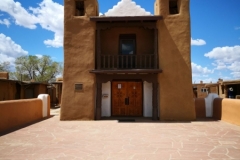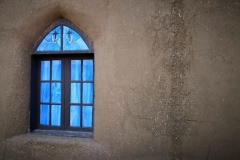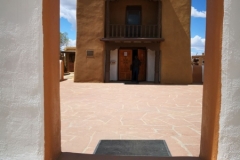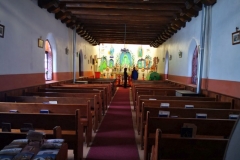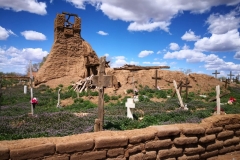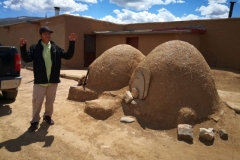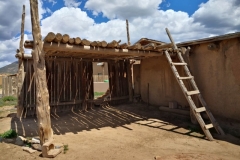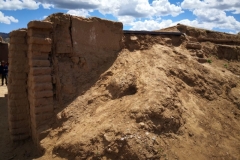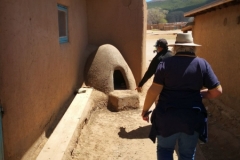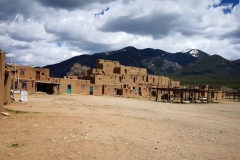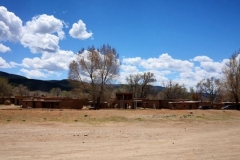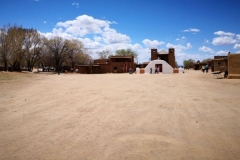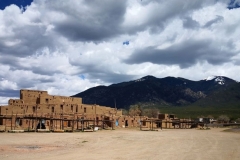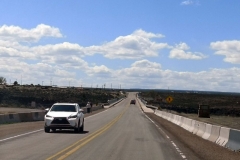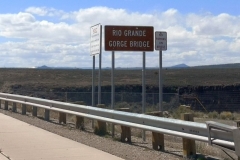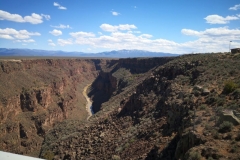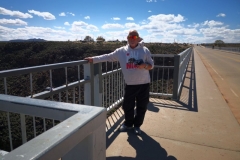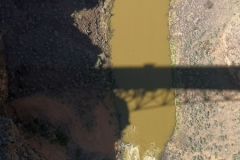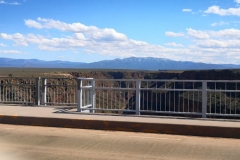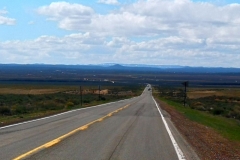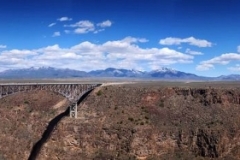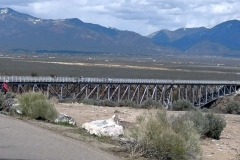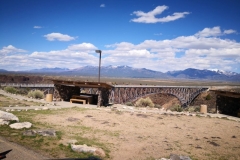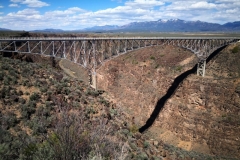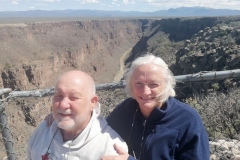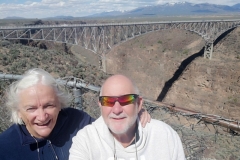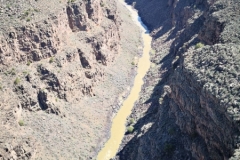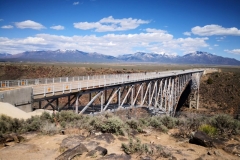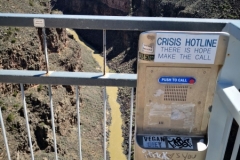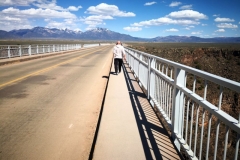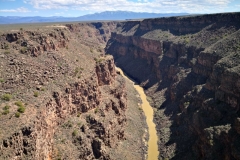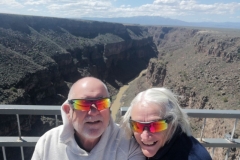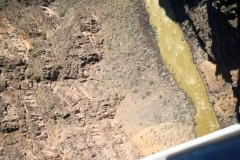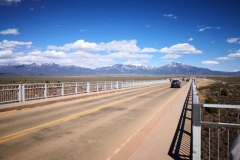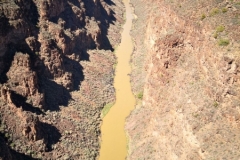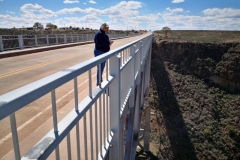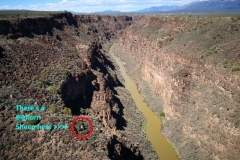At the end of the last post we were in Abq (Albaquerque) having a ball and being surprised by what New Mexico has to offer. Well we’ve moved on to Santa Fe and all I can say is hold on to your hat. Santa Fe is brilliant. We have previously run out of adjectives so don’t be surprised if we start repeating ourselves.
Instead of taking the main highway we chose to drive “The Turquoise Trail”. This entailed travelling for several miles on the famed Route 66 before turning north towards our goal. About 6 miles up the ‘Trail’ we took a side track off to a quirky little place known as Tinkertown Museum. Tinkertown is the lovechild of one man’s hobby that got out of hand and due to public demand became a museum. It is mostly filled with thousands of hand carved wooden figures in all sorts of situations. Where there are no dolls there are other odd bits and pieces which make this attraction a fun and interesting stop. Unfortunately while we were inside Tinkertown the weather had started to close in on us. (For my video of Tinkertown click this link)
Next stop for us up the ‘Trail’ was the old coal town of Madrid. Almost around the bend is the turquoise fields of Cerrillos. With the decline of coal and new interest in the blue turquoise artisans moved into town and rejuvenated what had almost become a ghost town. The galleries and craft stores line the main road but the main attraction is the Diner which was made famous in the Tim Allen movie “Wild Hogs”. That’s the diner in the first photo of Madrid. This town is a bit reminiscent of the old Nimbin we remember from years ago. From Madrid it was a short race to get to our RV Park at Santa Fe before the storms hit.
The next morning, after settling in to our new base, you wouldn’t know there had been storms about only a few hours previous so we went into Santa Fe city to check out the “Historic District”. Driving into town we were faced with a postcard view of snow capped mountains before hitting a gorgeous area around a central Plaza. You can see here why the ‘Pueblo Revival’ style architecture was often called ‘Santa Fe’ style. The buildings here are magnificent and with the verandahs over the footpath it is easy to imagine yourself in Santa Fe 1819 not 2019. Under the verandah of the “Palace of Govenors” there were traders of Native Indian descent pedalling their wares, mostly jewellery and pottery, at high prices to unsuspecting visitors who obviously hadn’t researched their spending. I was looking for an historic plaque regarding the development of the atomic bomb when I spied the object in a courtyard of the “East Palace”. Also in there was some stunning Talavera Pottery which immediately caught my eye. How I wish I could afford to buy this and send it home, especially that bird bath. I am also particularly won over by the “Day of the Dead” crafts, prints, clothing and more.
We continued our walk about the town when we came to the Cathedral Basilica of St Francis of Assisi which we had to inspect. Down a few streets and we passed many craft and art galleries till we came to another church. Loretto Chapel is famous for its’ “Miracle Stairs”, a spiral staircase that seems to have no means of support. After a huge pizza lunch we dropped into yet another church but this church has a genuine claim to fame. San Miguel Church is the oldest church in the USA having been built around 1610. Behind San Miguel Church is the oldest house in the USA having been built in 1646 on foundations laid by Indians around 1200 CE (AD). The crafts in the gift shop in this old house were also stunning as well as expensive.
The last dozen or so pics in this gallery start with my cooking up of Venison Stroganoff on German Spaetzle noodles. If you remember I mentioned buying the venison (& some Elk snags) in the last blog. I have finished with some random shots of the Saturday Farmers Market and Fort Marcy where the Cross of the Martyrs is placed overlooking the city Santa Fe really is one of the most interesting and attractive places we have visited. If anyone is over this way we highly recommend at least a few days stopover.
I’ve mentioned the Pueblo Indians a few times. Who are they? The Pueblo Indians are Native Americans who were found by the Spaniards in the 16th century although they existed in ancient times and covered much of the South West of the (current) USA and Central America. There is far too much for me to tell you about them in this blog but if I have piqued your interest try clicking on this link (https://en.wikipedia.org/wiki/Puebloans). The reason I raise them here is because our next stop (and another in the next blog) is so fantastic as not to be missed.
We awoke to a beautiful Santa Fe day and decided to hit the road to visit the ancient village of Taos Pueblo. This adobe brick village is one of only 19 left in existence and what is there is mind boggling. The people who live here are descendants of the original builders but think about this. The multistorey, mud brick buildings you see have been carbon dated at over 1000 years old. I repeat, one thousand years old! In this gallery I have pictures of their church (the Spaniards converted the Indians to Catholicism – though they practise their own hybrid combination of Catholicism and their native traditions) and cemetery. You’ll see the twin mud ovens of the bakery and I have a few pictures showing some of the construction materials. Traditionally the Pueblo Indians entered their houses from the roof, hence the ladders. Modern times has them build in doorways as the threat of enemy attacks is now long passed. Water is drawn from the river which is snow melt.
There’s a photo of Shane leaning on a low brick wall. In days gone by when attacks by enemy tribes were prevalent that wall was up to 4 feet (120cm) thick and 10 feet (300cm) high. While some have mod cons they still basically live a traditional lifestyle. They supplement their income through the sale of native arts and crafts some of which you’ll see towards the end of the gallery.
After several hours inspecting Taos Pueblo and chatting with some locals we hopped in the car to find a spot that was recommended to us by two ‘mature’ ladies we’d met earlier in the day. About 8 miles beyond Taos is the Rio Grande Gorge Bridge and wow, what a bridge. The road crosses a wide plain and we said to each other that “those mountains are more than 8 miles away. I hope this gorge is worth the trip.” What we weren’t expecting was a dirty big ‘crack in the earth’ in the middle of this flat environment which the Rio Grande has carved out over millennia. Standing 656 above the gorge floor this bridge is awesome. Several pictures need mentioning here. One is the suicide phone placed on both sides of the road mid-bridge. Apparently it is a popular place for jumpers. You might notice in the photo of Shane that she is standing well back from the railing (ha ha). In the pic after that I have circled a surprise sight that I spotted. A wild Bighorn Sheep was grazing in the gorge. It is a bit far to get a clear photo so you might have to study the next 3 pics to see it.
We took a heap of photos then headed back home through the township of Taos. Just a mile or two later we looked back and could see the rift from the elevated highway. We followed the Rio Grande again back to Santa Fe and I have added a few photos from the trip on the end of this gallery.
Well that’s it for this blog but not for Santa Fe. The next post will have some more of this fantastic city and the marvellous week we had there. Don’t miss it.
Cheers for now
Garry & Shane.
